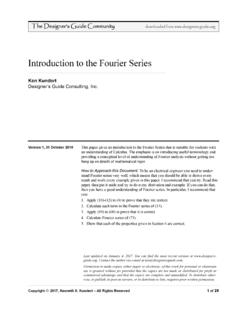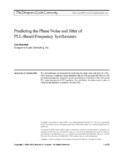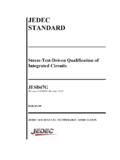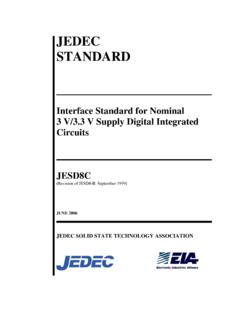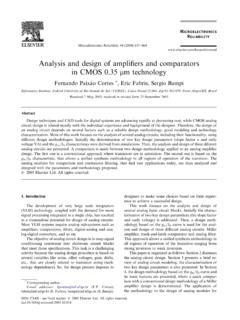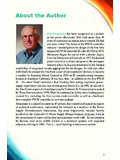Transcription of Modeling Skin Effect in Inductors - Designer's Guide
1 The designer s Guide Communitydownloaded from 2006, Kenneth S. Kundert All Rights Reserved1 of 10 Version 1a, October 2001 Presents a technique for Modeling skin Effect losses in Inductors . Includes a model writ-ten in Verilog-A as well as a model based on a new type of basic element named a manuscript was originally written in October 2001. It was last updated on May 12, 2006. You can find the most recent version at Contact the author via e-mail at to make copies, either paper or electronic, of this work for personal or classroom use is granted without fee provided that the copies are not made or distributed for profit or commer-cial advantage and that the copies are complete and unmodified.
2 To distribute otherwise, to pub-lish, to post on servers, or to distribute to lists, requires prior written skin Effect in InductorsKen KundertDesigner s Guide Consulting, of 10 The designer s Guide BackgroundIn the Coilcraft application note on Modeling RF Inductors [2], the inductor is modeled as shown in Figure 1. Component H in the model represents the skin - Effect loss. In the ap-note, it is modeled in two different ways. In the PSPICE version, it is written as .(1)For other simulation software, the model is written as.(2)These two models are not consistent in two ways.
3 First, (1) has a corner at 1 Hz whereas (2) does not. Second, Z(f) in (1) is complex while in (2) it is real. Once significantly above 1 Hz the real and imaginary are equal for the PSPICE model. Thus, for measure-ments made well above 1 Hz, k and H are related by(3)Having a purely real impedance that varies with is not physically realizable (it would be non-causal, as shown in the appendix) and so is clearly incorrect. However, the corner frequency at 1 Hz in the PSPICE model seems artificial. I expect that it was included to prevent the impedance from going to zero at DC, which causes problems for of (1) and (2), skin Effect is modeled here in a more traditional way.
4 (4)This model involves a non-integer power for f and so is a distributed model [1]. In other words, Z(f) cannot be exactly represented using a finite number of poles and zeros and the model cannot be implemented exactly by combining a finite number of lumped com-ponents (resistors, capacitors, and Inductors ). Modeling skin EffectA transfer function of is approximated over a finite range of frequencies with an equal number of real poles and zeros alternating and evenly spaced in a logarithmic FIGURE inductor ()Vf()If()------------1jf+H------------- -----==Zf()kf=k12H-----------=fZf()jfH-- -------=jfModeling skin Effect3 of 10 The designer s Guide over that range, as shown in Figure 2.
5 The range of the approximation is from f0 to f1, with the impedance flattening out at frequencies outside of this range. The range of frequencies over which skin Effect must be accurately modeled can be determined by examining its contribution to the overall impedance of the inductor. The impedance of a representative inductor is shown in Figure 3. Notice that the impedance is separated into its real and imaginary parts (the resistance and the reactance). The resistance represents the loss. It is important to accurately model the resistive portion in the operating fre-quency range even where the reactive portion is much larger because it determines the Q of resonators and because designer sometimes use tuning to cancel out the reactive we do not know the operating frequency range a priori, we must model the skin Effect over the range of frequencies where it is significant.
6 The low frequency bound, f0, is chosen to be the frequency where the impedance of the skin Effect dominated over Rs. FIGURE the nature of skin Effect using a collection of real poles and impedance of an RF inductor separated into real (R) and imaginary (X) Zlog fmf0 Coilcraft A01T Mini Spring1m 10m 100m 1 10 100 1k 10kHz 100kHz 1 MHz 10 MHz 100 MHz 1 GHz 10 GHz 100 GHzXRRpRs2 fL1/(2 fCp)f2H2---------- Modeling skin Effect4 of 10 The designer s Guide our lumped approximation of skin Effect naturally flattens out at low frequency, Rs will be combined with H to form HR as shown in Figure 4.
7 Notice that the structure of the model was modified slightly to accommodate the combining of Rs and H. Since Rp is always much larger than Rs, the difference is not expected to be low frequency bound, f0, is the frequency where the resistance (the real part) of the skin Effect begins to dominate over Rs.(5)The high frequency bound, f1, is chosen to be the resonant frequency of LCp, because above this frequency the capacitive path through the inductor dominate over the induc-tive path, and so Rp dominates over H. (6)Placing f1 at the resonant frequency L and Cp does act to increase the modeled Q of this parasitic resonance, but does not significantly affect the Q in the operating frequencies of the number of lumps, n, is chosen to provide a sufficient level of accuracy.
8 The larger n, the closer the impedance of the lumped approximation matches . Typically, using 1 lumps per decade of frequency range give a good fit (but 1 lump per decade is often sufficient).(7)The frequency span of one lump is then(8)From Figure 2, the zero and pole frequencies are simply(9)(10)FIGURE RF inductor ()2=f112 LCp---------------------=jfn32---f1f0--- log=mf1f0-----n=fzimi34--- f0=fpimi14--- f0=Verilog-A Inductor Model5 of 10 The designer s Guide i ranging from 1 to n. For the inductor shown in Figure 3, impedance of the model for just the skin Effect is shown in Figure 5.
9 In this example, f0=25kHz and f1= 65 GHz. It is clear that accuracy degrades at the ends of the range. If accuracy at the ends is important, consider lowering f0 and/or raising f1by and order of Verilog-A Inductor ModelA model is derived assuming that the Coilcraft parameter values are available. If they are not, one can extract them graphically from measured data as illustrated in Figure 3. The model of the inductor itself implements Figure 4 and is given in the form of a Ver-ilog-A [4,7] netlist in Listing 1. It uses (5) and (6) to compute f0 and f1 for the skin Effect model.
10 The parameter esr specifies Rs and rcp specifies Rp. Both H or k are parameters, even though they specify the same thing. Just give one. Finally, the netlist used to test the model is given in Listing 3 shows the module that implements the skin Effect model. It is based on (7), (8), (9), and (10). The model starts by computing the location of the poles and zeros needed to achieve the transfer function shown in Figure 2, and then implements the transfer function using the laplace_zp ResultsFigure 6 shows the impedance exhibited by the model compared with measured data.
